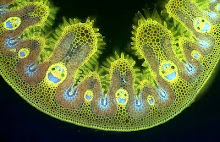This spectacular lily is a native of Africa, where it is the national flower of Zimbabwe, and also of India where it is the state flower of Tamil Nadu. It’s a climber, using its leaf-tip tendrils (see backing photo for the title panel of this blog) to cling to supports. If it’s left to scramble through other plants in a conservatory it will grow to a couple of metres tall and typically produces 5-6 blooms. The plant grows from an underground tuber and is easy to cultivate in a warm conservatory in summer, but you need to be careful to keep the tubers dry during winter, otherwise they rot off very easily. All parts of the plant are poisonous and the tubers particularly so, since they contain the toxic alkaloid colchicine (from which the family name is derived). Like many poisonous plants it has a long history of use in folk medicine and along with several related genera that contain colchicine it has been used to treat gout – see http://www.patient.co.uk/medicine/Colchicine.htm . In Africa and India there has recently been a resurgance in interest in extracting a broad spectrum of medicinally useful and antimicrobial compounds from the plant, even to the extent of growing it as a crop, but it’s those flame-like flowers that make it horticulturally interesting. It's often sold under the names flame lily, Gloriosa superba Rothschildiana or G. rothschildiana, and there are yellow-flowered cultivars available. Older literature places it in the plant family Liliaceae. One distinctive floral peculiarity is the way in which the stigma bends through 90 degrees and pokes out of the side of the flower. This is possibly an adaptation to pollination but there seems to be little information on the pollinators of this plant, other than that bumblebees and purple sunbirds (Nectarinia asiatica) http://en.wikipedia.org/wiki/Purple_Sunbird have been seen visiting it.
Flower viewed from below















